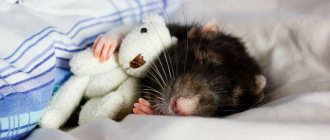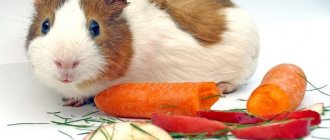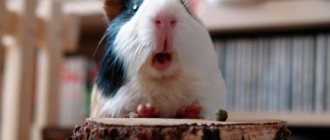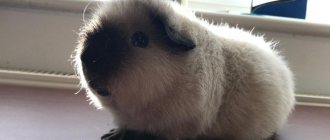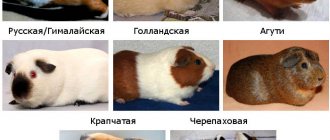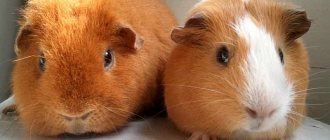A furry pet often leaves its owner unexpectedly. Unfortunately, the laws of nature predetermine the pattern - that the smaller the living organism, the less life is measured. Guinea pigs, as one of the smallest human companions, do not live long.
Their life span is 5-8 years, and serious illnesses and injuries ultimately shorten such a short existence.
When you get yourself a furry friend, you need to remember that sooner or later the pet will leave the owner.
Signs of a Dying Pet
A caring owner who devotes significant time to his pet can always identify signs of approaching death by noting a change in habitual behavior:
- Lack of appetite. A healthy pig will never refuse a treat or new food in the diet.
- Decreased activity. A pet in good health always shows curiosity and conducts exploratory forays with interest. In a young pig, fatigue and slow movements mean excess weight gain and possible obesity, as well as natural laziness.
- Labored breathing.
- Uncontrolled release of feces.
- Slow reflex movements and lack of response to stimuli.
Old age of the pet
The onset of signs of old age in a guinea pig is expressed in sluggish movements, decreased appetite and loss of interest in companions, including the owner. The animal gradually loses weight, its coat becomes dull and disheveled . An older rodent avoids games, sleeps more and looks weakened. The old animal exhibits:
An elderly pet looks sick and weak
- Cloudy eyes and cataract formation.
- Arthritis. The appearance of internal thickenings on the joints of the fingers.
- The presence of tumors under the fur.
- Difficulty moving the paws due to stiff joints.
Alas, old age cannot be delayed. You can only try to prolong the animal’s life with caring care, a diet enhanced with vitamins and leisurely walks.
Regular visits to a specialist will help identify the early stages of possible diseases. After all, even a common cold causes serious complications on the functioning of the heart and internal organs and can lead to death.
In addition to senile decline, the death of a guinea pig occurs for a number of reasons:
- Birth defects or genetic predisposition.
- Digestive diseases associated with improper feeding.
- Viral and infectious infections.
- Parasitic diseases.
- Mechanical damage to organs from falls or injuries.
Caring for your pet extends life to 10-12 years.
Various infections
Contrary to popular belief, these animals often get sick. The fact is that a person cannot always competently comply with all conditions of detention. For example, if there is also a dog in the apartment, then sometimes it may even turn out that it brings home some kind of infection on its paws. As a result, the rodent becomes infected, but the dog remains healthy. It is almost impossible to prevent such cases. If this happens, it is recommended to immediately take your pet to a veterinary clinic. Treatment will not be cheap, but the pet can be saved. Infections are also dangerous because the course of the disease can be completely asymptomatic for some time.
Deadly diseases of guinea pigs
Despite a strong immune system, your pet can get sick. The reason may be lack of care, lack of vitamins or a sudden change in diet. The most dangerous diseases that lead to the death of a pet are viral infections.
Enteritis
The lack of vital nutritional components (hay, grass) causes an infectious disease, the causative agent of which is Escherichia coli. The bacillus develops rapidly in the animal’s intestines and digestive organs.
A bloated belly feels hard to the touch
First symptoms:
- Bloating.
- Refusal of food and drink.
- Fever.
- Diarrhea with blood clots.
- Wheezing in the lungs.
- Paralysis of limbs.
- Body convulsions.
Without prompt veterinary intervention, the animal dies from loss of fluid in the body.
Salmonellosis
A virtually incurable disease. The source of infection is animals, food with a large amount of protein or water contaminated with salmonella bacilli. The first sign is:
- Complete refusal of the animal to eat and drink.
- Profuse salivation.
- Diarrhea.
- Intermittent breathing.
- Heat.
- When examining the abdomen, bloating is observed.
Without the help of a specialist, the rodent dies within a day. At an early stage of the disease, the pet can be saved; delay involves euthanasia. It must be remembered that the disease is contagious to humans . In any case, disinfection of the room and cage is required.
Pseudotuberculosis
An extremely dangerous disease transmitted through contaminated food or drink. The disease caused by bacteria is fleeting and can affect all inhabitants of the cell. Manifests itself in symptoms:
- Loss of appetite.
- Lethargy.
- Increased body temperature.
- Severe diarrhea.
- Convulsions progressing to paralysis of the legs.
Pseudotuberculosis cannot be cured . The animal dies from lack of fluid in the body and paralysis.
Pneumonia
Pets with weakened immune systems and vitamin deficiencies are prone to the disease. Pathogens include disgusting rodent maintenance and poor quality nutrition, as well as infection from a sick owner.
The pig may not eat at all or eat little by little
The first signs of respiratory disease are:
- Refusal of food.
- Weakness and indifference.
- Frequent drinking.
- Discharge of pus through the nasal sinuses, which the animal tries to get rid of on its own by wiping its nose on the bedding, or trying to clear its nose with its paw.
- Shallow, rapid breathing.
- Heat.
- Short convulsions.
When characteristic symptoms appear, the rodent must be isolated from people and animals. A timely visit to the veterinarian and quick medical assistance can save your pet.
Intestinal problems
In decorative guinea pigs, diseases of the digestive system can be associated with infections (not necessarily intestinal), hypothermia of the animal and poor diet. A clear symptom of dysfunction of the digestive tract is the pet’s refusal of its favorite food.
Intestinal symptoms during hypothermia
Severe hypothermia in the pig can also lead to indigestion. It is characterized by diarrhea and lethargy of the animal.
Tympany
Bloating caused by the processes of fermentation and gas formation in the animal’s intestines usually bothers guinea pigs in the spring. The disease is accompanied by tachycardia, breathing problems (the swollen intestines prop up the diaphragm, which puts pressure on the lungs, shortness of breath appears), refusal to feed and muscle spasms. The pet's abdomen is swollen, and a “drumming” sound is heard when tapped. The main cause of the disease is an illiterate selection of food for the animal.
Abnormal stool (constipation)
This disorder of defecation is not an independent pathology, it accompanies:
- inflammatory diseases of the gastrointestinal tract of mumps;
- helminthiasis (cestodiasis, oxyuridosis - it is registered very rarely in guinea pigs and often occurs without symptoms);
- ingestion of foreign objects;
- tympany;
- may develop due to lack of fluid;
- or violation of feeding rules.
It is accompanied by lethargy of the animal, sometimes the pet takes a forced position, refuses food, and cannot empty its intestines for several days. On palpation, tight intestinal loops clogged with feces can be clearly felt. Long-term constipation can cause the intestinal wall to rupture. And the death of the animal due to peritonitis.
Non-infectious enteritis
The intestines of this rodent are adapted to digest roughage, but its microflora is particularly sensitive. If the animal's microbiocenosis is disrupted, the mucous membrane of the small intestine may become inflamed and enteritis may develop.
In some cases, indigestion can be very severe and even fatal for mumps, for example:
- sudden change of food;
- low-quality feed (rotten, moldy);
- There is a large amount of grains in the animal’s diet and a lack of herbs.
At the same time, the animal develops diarrhea, loses appetite, activity, and loses weight. Eating poisonous grass can cause serious poisoning.
Infectious enteritis
Infectious enteritis in guinea pigs is caused by bacteria and protozoa. This group includes salmonellosis, colibacillosis, trichomoniasis and amoebiasis.
An intestinal infection caused by salmonella. Causes profuse diarrhea and death in guinea pigs. Pigs rarely get sick. It is not very treatable. The disease is dangerous for humans.
Colibacillosis or Escherichiosis is caused by the opportunistic pathogen Escherichia coli. This microorganism does not “live” in the intestines of guinea pigs. Its appearance is accompanied by bloody diarrhea and ends in the death of the pet.
When Trichomonas is infected, the intestinal walls of the pig become inflamed and diarrhea begins. The animal quickly becomes exhausted. The same symptoms accompany amoebiasis.
Coccidiosis
The disease is caused by coccidia. It is an intracellular parasite that attacks the intestinal wall of the guinea pig. Coccidia can parasitize in the intestines of an animal without causing harm to it. And only with active reproduction, in case of weakening of the animal’s body, the process takes an acute course, leading to the death of the animal. Moreover, from the moment clinical symptoms of enteritis appear (diarrhea, refusal to eat, lethargy) until the death of the pig, very little time passes, sometimes the owner does not even have time to contact the veterinarian.
Fascioliasis
This is a helminthiasis caused by Fasciola hepatica. The parasite “lives” in the bile ducts. The disease is accompanied by loss of appetite and lethargy of the pet. The pathology is dangerous for humans.
How to save a dying guinea pig
Often, while waiting for a specialist, the owner himself can provide first aid to a dying pet, which will undoubtedly prolong its life and preserve its health.
- In case of an allergic attack and swelling of the throat, the animal is immediately given an antihistamine.
- If an animal chokes on food, you need to carefully examine the oral cavity and remove the stuck piece. If the food penetrates deep into the throat of the rodent, you should place it on your hand with its belly up and its muzzle towards the elbow. With a light but confident movement, run your finger along your throat, pushing the food into the esophagus. Afterwards, give the rodent something to drink from a syringe (without a needle!) and give it solid, juicy food.
- If the animal refuses to eat, it must be force-fed to maintain viability. Food based on baby vegetable puree is administered by syringe every two hours in small portions, as well as water with added vitamin C.
- In case of poisoning with low-quality food, the animal’s stomach is washed with 0.1% potassium permanganate. After the procedure, you need to give the patient a drink of rice broth or oak bark decoction.
- In case of hyperthermia, the pet should be moved to a cool place and covered with a damp cloth.
Clear and decisive actions by the owner will help avoid suffering for the pet.
Hair loss
A symptom that also needs to be paid attention to, and not try to pretend that what is happening is absolutely unimportant. Hair loss is always a sign of trouble. Of course, when faced with such manifestations, it is not at all necessary to immediately begin feverishly preparing for the death of your pet. It is necessary to analyze the situation to understand how you can help the animal. It is quite possible that he simply does not have enough vitamins. However, you should not brush it off if this is followed by more serious symptoms that require immediate attention. If your guinea pig died suddenly, there is likely nothing you could do to help it.
Euthanasia
Unfortunately, due to old age, acute viral infection or severe mechanical injury, the pet’s life slowly fades away, and the suffering becomes unbearable to watch.
Euthanasia of a pig will be humane if the pet is suffering
No matter how painful it may be, euthanasia of a pet relieves it of pain .
At the beginning of the euthanasia procedure, the animal is given a strong anesthesia, after which the animal falls asleep. A subsequent medication, administered minutes later, stops the heart.
A doctor’s visit to your home or a visit to the clinic with your pet is the owner’s decision. A life-saving injection from pain and suffering costs from 1000 rubles.
Impaired coordination of movements
If your guinea pig has died, you need to remember how it moved around the cage the last few days. If there was a lack of coordination of movements, it means that the owners really missed this moment. A healthy individual constantly runs and is active. In most cases, if an animal stops moving normally, there is something wrong with it. It’s just that not a single representative of rodents sits still without sad consequences for themselves. Any lethargy indicates that you need to be especially vigilant and be ready to solve emerging health problems.
Common causes of death
Childbirth
Despite the fact that the guinea pig is considered the most prolific rodent, difficult situations associated with risk to life arise during pregnancy and after childbirth. Frequent occurrences are:
- Toxicosis. Occurs in the last week of pregnancy or in the first days of birth of the offspring. The reason is poor maintenance and care. It is impossible to help an animal with the development of toxicosis .
- The remaining placenta in the uterus.
- Complications during difficult childbirth. If there is obstruction of the birth canal or vaginal prolapse, immediate surgical intervention is required.
The death of offspring is observed if the female refuses to feed the babies.
Fight
Rumors about the superior fighting qualities of males in the same cage are exaggerated. Fighting for the female's attention, opponents can inflict injuries on each other, including deep lacerations. But there were no deaths.
After anesthesia
During surgery, the dose of anesthesia for the rodent is carefully calculated. However, death can occur from advanced disease or due to pathology of the heart muscle.
Sudden death
Cases of unexpected death of a pet happen, like every living creature. The factors can be varied; an autopsy of the pet will help determine the cause.
Improper care
If the cage is located in a draft, sooner or later this will negatively affect the health and well-being of the pet. An animal can catch a cold easily, and treating a pet is not as simple as it might seem at first glance. You need to have additional knowledge or at least be able to immediately contact a good specialist. Improper care has consequences for any animal. Guinea pigs are quite gentle and vulnerable creatures. If you don't keep an eye on them in time, they will leave you much earlier than you expect. For example, few people know that this type of rodent must be kept in same-sex couples. Alone they become bored and sad.
And raising pigs is a rather difficult and problematic task. There is no need to take on this without special knowledge. If your guinea pig dies unexpectedly, you need to carefully analyze the situation. Perhaps you did something wrong, were inattentive to the changes taking place. Just try to take into account the mistakes you made and not repeat them in the future.
Can he die from fright or melancholy?
The animal may completely refuse to eat and sleep, mourning its friend.
The guinea pig has a weak nervous system . The animal is quite timid and experiences stress from any incomprehensible incident.
A guinea pig can die from severe fright. Such facts are known. Rodent owners should take this information into account and treat the animal with care.
The animal is dependent on the company of other rodents and, if lost, is capable of yearning for it and even mourning it. Refusal of food or withdrawal from contact indicates a feeling of grief . In order not to lose your pet, you should introduce a new friend, relieving loneliness.
Old age
In most cases, guinea pigs live for about seven to eight years. This is the average number of years that future owners typically look at when making a purchasing decision. After all, no one wants to say goodbye to their favorite animal too quickly. Common problems and fatal diseases in guinea pigs often mean that the animals live even less: only five to six years. This is also a normal indicator. Just losing a furry friend is always difficult and sad, which is understandable. Old age cannot be canceled or prevented.
How to cope with the loss of a pet?
Sadness for a departed pet is natural. The years spent together are priceless. Tears will help you get out of shock. Remembering your pet's antics, talking about his antics and sharing your feelings with loved ones can help you cope with the loss more easily.
Of course, the departure of a pet is a heavy loss not only for the other inhabitants of the cage, but above all for the pet’s owner. To prevent premature loss, you should take care of the animal throughout its life, pamper and love it.
Severe stress
If the owner often moves from one place to another, then this is a lot of stress for his four-legged friend. He can get sick simply because living conditions are constantly changing. Temperature changes also have a detrimental effect on health. Severe stress can be compounded if the owner at some point decides to place their pet in the hands of another person. Animals sometimes find it difficult to get used to changed living conditions. If they lived in a cage as a pair, then after the death of a relative, the second individual will be sad and yearn.
Interesting features of other sensory organs
Hearing
The cochlea of the human ear has only two turns, but these rodents have four. Due to the special structure of the cochlea of the inner ear, guinea pigs have excellent hearing.
Smell
Rodents most often use their sense of smell for contact with each other and during the mating season. Since the animals live in communities, they are able to recognize a stranger by smell.
They specifically mark their territory with urine to help them understand boundaries. In familiar smells, pigs feel calm and confident, but as soon as they find themselves in an unfamiliar environment, they begin to worry and become scared.
If we compare a rodent’s sense of smell with a human’s, we can note that the animal’s sense of smell is a thousand times sharper. They are able to distinguish a huge range of odors that are invisible to the human nose. Therefore, the owner of the animal often does not understand why the baby is worried.
While eating food, pigs use their sense of smell to determine which foods they can eat and which they cannot. The same applies to the people around them: they identify their owner by smell. Animals in any situation first trust their sense of smell, and only then other organs.
Touch
Guinea pigs have tactile hairs around their mouth and nose. They help animals navigate in space and act as a kind of probes.
With their help, animals determine whether there are obstacles in their way, whether there is an opportunity to get into this or that hole.
Taste perception
Sometimes the animal's sense of smell can fail. Then taste receptors come to the rescue. With their help, the animal will determine the quality of the food.
If a rodent has to choose between sweet and salty, it will choose the first. But he can calmly eat bitter food. In general, each individual has its own taste preferences.
Sound perception
What sets guinea pigs apart from other rodents is the wide range of sounds they make. Starting from simple muttering expressing pleasure; cooing, a sound with which they establish interpersonal contacts, ending with the clicking of teeth, with which they notify of an imminent attack for the main role among males.
Guinea pigs have a rich range of sounds that they are capable of making. For example, young individuals squeak piercingly, calling their mother to come to their aid. At the same time, females respond less and less each time to the call of the young. They do this deliberately in order to accustom their children to independent living.
Mature individuals are able to make sounds that express fear. A person can easily recognize them. If animals live in groups, then you can notice that if one individual begins to make a sound of danger, then all the others, one after another, hurry to hide in a shelter.
But guinea pigs sometimes experience stupor during severe fright. The animal freezes and remains motionless for a long time. It is believed that this is a form of self-defense.
Despite the fact that the vision of rodents is not well developed, nature has endowed them with acute hearing, a sensitive sense of smell, and excellent perception of tastes. Thus, with the help of its senses, the animal is able to protect itself from danger, and, if necessary, hide in a safe place.
Gymnastics
There are exercises that allow you to train the vestibular apparatus. Perform this complex regularly, and over time you will experience less motion sickness.
Lie on your stomach. Slowly move your head back. Roll over onto your back, slowly tilt your head forward, try to touch your chin to your chest. Repeat the exercise 4-5 times.
Lie on your back. Relax and, without straining your neck muscles, shake your head left and right for 2-3 minutes.
Sitting on a chair, keep your head still, roll your eyes first clockwise (5-6 times), and then counterclockwise the same number of times. Repeat the exercise 2-3 times.
Stand with your feet shoulder-width apart. Slowly tilt your head forward until your chin touches your chest, and then tilt your head back as far as possible. Perform 6–10 times.
While standing, slowly turn your head left and right, 5–10 times in each direction. Make slow circular movements with your head to the right, then to the left. Repeat 4-5 times.
Longhair
Unusual and beautiful guinea pigs with long hair come in completely different varieties and have the most unusual names. At first glance, it is very difficult to understand which animal is in front of your eyes: a shaggy dog or a fluffy bunny. These thoroughbred “hippies” appeared thanks to the incredible efforts of breeders. Almost all rodents have thick and long hair, which in some breeds can exceed 45 centimeters.
Sheltie
These guinea pigs are very nice to touch as they are quite soft to the touch. Their fur, unlike other relatives, does not have a parting, but simply falls back. The hair on the head is thicker and somewhat resembles a mane. Like other long-haired animals, Shelties are friendly and calm.
Coronet
These are the most active representatives among all guinea pigs with long hair. Their characteristic feature is a single rosette on the head. The long fur flows on both sides, but does not cover their face.
Alpaca
This beauty has very long and curly fur. It looks a little like sheep's wool. In addition, it grows towards the head. There are 2 rosettes on the sacrum, another one is located on the head, and looks like a bang.
The fur on the face is a little coarser than on the rest of the body. Alpaca guinea pigs are quite compact, with small and neat ears. Their color is very different - from black to golden. In rare cases, you can even find two-color or three-color alpacas.
Texel
This is the most beautiful breed of long-haired guinea pig, and it was the result of crossing two breeds: Sheltie and Royal (Rex). Their curly fur grows from the head. In addition, it cascades across the entire back from the parting, framing the head without long hair. The length of the hairs can reach up to 15 centimeters.
This breed of pigs is a bit like fluffy balls that you want to pick up. They have beautiful big eyes and small ears shaped like rose petals. The color of the texels is quite varied. Among them you can even find white guinea pigs.
Merino
Such guinea pigs are also called royal guinea pigs, and all thanks to their beautiful and curly hair. Their head is decorated with a rosette that resembles a crown. The fur is very long, so owners often have to cut their pets in the summer. Their color can be white or gray, and also combine several shades at the same time.
Peruvian
This breed of pigs has become quite popular due to its docile nature, as well as its beautiful appearance. Their fur is very soft and long, so it requires constant care. There are rosettes on the sacrum and also on the nose. The animal's face is covered with long bangs.
Peruvian guinea pigs can be single or multi-colored, but most often their color is silver-gray. They live no more than 6 years and weigh up to 1.5 kilograms.
Kui
This is the largest breed of guinea pigs, sometimes weighing up to 4 kilograms. Most often they are raised for meat. Cuis are more considered to be smooth-haired breeds of pigs, but among them it is worth noting Peruvian animals that are bred as decorative creatures.
This species reproduces poorly and is also prone to various diseases. In addition, they have a very aggressive character. Almost all kui have 5 or 6 toes on their paws, however, this does not bother them at all. Most of them do not live very long, within 3 years.
Eye diseases
Eye diseases develop for various reasons.
A guinea pig's eye becomes suppurated, usually due to conjunctivitis; it can be caused by mechanical damage, bacteria, viruses, fungi and parasites.
The disease is characterized by the following clinical manifestations:
- eyes fester and water;
- photophobia;
- due to pus, the eyelids stick together;
- clouding of the cornea, pupils do not respond to light.
It is better to ask your veterinarian what to do if the disease develops. He will tell you what medications can be used if pathology appears. Since viral and bacterial conjunctivitis are treated differently.
Less commonly, guinea pigs are diagnosed with keratitis, which appears as a result of corneal injuries. As a rule, pathology is detected when the pet has clouding of the cornea. For treatment, antibacterial medications are prescribed in the form of drops and ointments, which must be applied every 2 hours.

